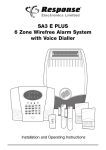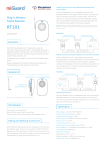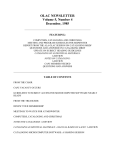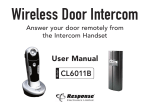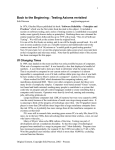Download Response SA1 E PLUS Operating instructions
Transcript
SA1 E, SA1 E PLUS, SA1PF E and SA2 E Alarm Systems 0 1 2 3 4 5 6 1 7 8 9 2 Installation and Operating Instructions Contents Page No. Kit Contents 3 Introduction and Overview 4 System Arming 4 Entry/Exit Delay 4 Alarm Lockout 4 Tamper Protection 4 Jamming Detection 4 Battery Monitoring 4 System House Code 4 Planning and Extending your Wirefree Alarm System 5 Remote Control Unit Page No. External Solar Siren 15 Choosing a Location for the Solar Siren 15 Installing the Solar Siren 15 Setting the Solar Siren 16 Initial Power-Up of the Solar Siren 17 Siren Service Mode 17 Siren Operating Mode 17 Testing the System Testing an Installed System 18 18 Operating Instructions 19 6 Arming the System Arm Delay-Arm 19 19 19 Setting the Remote Control 6 Disarming the System 20 Testing the Remote Control 6 Personal Attack (PA) Alarm 20 Device Tamper 20 Battery Monitoring 20 Remote Keypad 7 Positioning the Remote Keypad 7 Installing and Configuring the Remote Keypad 7 Inputting the House Code 8 Resetting to Factory Default 8 Changing the User Access Code Maintenance 22 Alarm Record 23 9 Troubleshooting 24 Disabling the Remote keypad 9 Extending your Alarm System 26 Testing the Remote Keypad 9 Notes 27 Replacing the Batteries 9 Anti-tamper Protection 9 Component Specification 28 Passive Infra-Red (PIR) Movement Detectors 10 Positioning the PIR Detector 10 Installing and Configuring the PIR Detector 11 Setting the PIR Detector 11 Testing the PIR Detector 12 Magnetic Contact Detectors 13 Positioning the Magnetic Contact Detector 13 Installing and Configuring the Magnetic Contact Detector 13 Setting the Magnetic Contact Detector 14 Testing the Magnetic Contact Detector 14 For a Control Panel operated system please refer to the Operating and Installation Instructions supplied with the Control Panel 2 Kit Contents Alarm System SA1 E SA1 E PLUS SA1PF E SA2 E Also included: Components included: External Solar Siren 1 1 1 1 Installation & Operating Instructions Remote Control 1 1 1 1 Fixing pack PIR Movement Detectors 2 2 0 2 Magnetic Contact Detectors 0 2 4 2 Remote Keypad 0 0 0 1 Batteries included: The type and number of each battery included will depend upon the components included in the System purchased. 6V/1.2Ah Sealed lead acid battery (for the External Solar Siren) 9V PP3 Alkaline battery (for PIR Movement Detectors and Remote Keypad) 3V CR2032 Lithium cells (for Remote Control and Magnetic Contact Detectors) 0 1 2 3 4 5 6 1 7 8 9 2 Remote Keypad (SAKP E) Remote Control (SAR E) PIR Movement Detector (SAP E) Magnetic Contact Detector (SAM E) External Solar Siren (SASS E) Important: Kit contents as Alarm System configuration table (top of page). Note: Diagrams are for illustration purposes only actual appearance may vary. For a Control Panel operated system please refer to the Operating and Installation Instructions supplied with the Control Panel 3 Introduction and Overview for more than 30 seconds or if the system is jammed for more than 3 periods of 10 seconds in a 5 minute period. (The Siren will emit a series of rapid beeps for 5 seconds as a pre-alarm warning 10 seconds before a full alarm occurs). System Arming The system has an Instant-Arm and Delay-Arm mode. If the system is armed in Instant-Arm mode then all detectors will immediately become fully armed. Any detector triggered while the system is armed will immediately sound an alarm. The jamming detection circuit is designed to permanently scan for jamming signals. However, it is possible that it may detect other local radio interference operating legally or illegally on the same frequency. If it is planned to operate the jamming detection feature we recommend that the system is monitored for false jamming alarms for at least 2 weeks prior to leaving the jamming detection function permanently enabled. Entry / Exit Delay If the system is armed in Delay-Arm mode this will activate the system with a 15 second entry/exit delay period. This allows a 15 second period for the user to exit the property after setting the system with the Remote Control or the Remote Keypad. Any detector triggered while the system is armed will cause an alarm condition after the 15 second entry/exit delay has expired. This allows time for the system to be Disarmed before an alarm sounds when re-entering the property. Battery Monitoring All devices powered by non-rechargeable batteries incorporate a battery level monitoring feature which will warn of a low battery status. The batteries on any device indicating a low battery status should be replaced immediately. Note: To conserve power and maximise battery life the PIR Detector will only detect movement if there has been no movement detected within the previous 2 minutes. Consequently the PIR Detector will not become active until the protected area has been free from movement for more than 2 minutes. System House Code Alarm Lockout In order to prevent any unauthorised attempt to operate or disarm your system, you must configure your system to accept radio signals only from your own system devices. This is done by setting a series of 8 DIP switches in all devices to the same ON/OFF combination (the House Code) selected by the user/installer. If a detector is triggered while the system is armed, the alarm will sound. After the set alarm duration has ended, the alarm will stop and the system will automatically reset. Subsequent detectors triggered will again sound the alarm. If the alarm is triggered more than 3 times then it will become ‘Locked Out’ and any further alarm signals will be ignored until the system is re-armed. ECE ON e.g. Tamper Protection 1 All system devices (except the Remote Control) incorporate Tamper protection features to protect against unauthorised attempts to interfere with the device. 2 3 4 5 6 7 Switch 1 = set to ON position 8 The House Code is set up by moving each of the 8 DIP switches in each device to the same randomly selected ON/OFF sequence. When setting the DIP switches, ensure that each switch ‘clicks’ fully into position. Use the tip of a ballpoint pen or a small screwdriver to move each switch in turn. Any attempt to remove the battery cover from any device (except a Remote Control) or to remove the Siren from the wall will trigger an alarm (unless the system is in Service Mode), even if the system is Disarmed All devices must be configured with the same House Code in order for the system to operate correctly. Jamming Detection IMPORTANT: It is important that the system House Code is always changed to a code other than the factory setting and that all devices are configured with the same House Code in order for the system to operate correctly. In order to detect any attempts to illegally jam the radio channel used by your alarm system, a special jamming detection function is incorporated in the Siren. If this feature is enabled, an alarm will be triggered if the radio channel is jammed continuously 4 Planning and Extending your Wirefree Alarm System The example below shows a typical property incorporating the suggested positions for the Remote Keypad, PIR and Magnetic Detectors for optimum security. Use this as a guide for your installation in conjunction with the recommendations contained in this manual for planning your intruder alarm system. External Solar Siren Magnetic Contact Detector PIR Movement Detector PIR Movement Detector Remote Control 0 1 2 3 4 5 6 1 7 8 9 2 Remote Keypad Magnetic Contact Detector SHED PIR Movement Detector PIR Movement Detector Back Door KITCHEN DINING ROOM HALL LOUNGE GROUND FLOOR GARAGE PIR Movement Detector Before attempting to install your Alarm System it is important to study your security requirements and plan your installation. The alarm system may be extended at any time to provide even greater protection by fitting additional devices to meet your personal security needs. 5 Remote Control Unit Setting the Remote Control The Remote Control Unit is used to Arm and Disarm the system. 1. Remove the front cover by undoing the small screw on the rear of the Remote Control. Transmit LED Arm Delay-Arm Disarm House Code Dip Switches Slide up to operate Jumper Link Personal Attack Battery Clip Battery The Remote will activate the Instant-Arm, Delay-Arm or Disarm functions. The Remote Control also incorporates a Personal Attack Switch (PAS). Activating the PAS will immediately initiate a Full Alarm condition whether the system is Armed or Disarmed, (unless the system is in Service, Test or Program mode). 2. Any number of Remote Controls can be used with your system, providing they are all coded with the same system House Code. Located above the battery is a row of 8 DIP switches. Select and record a random combination of ‘ON’ and ‘OFF’ positions for the DIP switches. This will be the system House Code and must be set to the same ON/OFF combination as the House Code DIP switches in all other System Devices. Important: The House Code for your system should be changed from the factory default setting. The Remote Control is powered by a CR2032 type Lithium Cell battery which under normal conditions will have a typical life in excess of 1 year. Under normal battery conditions the LED on the Remote Control will only illuminate when a button is pressed. However, under low battery conditions the LED will flash every time the button is pressed. When this occurs the battery should be replaced as soon as possible. 3. To utilise the panic facility on the Remote Control, remove the Jumper Link. If ‘panic’ is not required leave the Jumper Link in place. 4. Remove the battery from its packaging and insert it under the clip ensuring that the +v terminal faces upwards away from the PCB. 5. Replace the front cover and fixing screw. Testing the Remote Control 6 1. Press the button. The Transmit LED should illuminate while the button is pressed and extinguish within 1 second of releasing the button. 2. Press the and buttons in turn to ensure that the Transmit LED illuminates as before. Remote Keypad Included in SA2 E system, available as an optional accessory for the SA1 E, SA1 E PLUS and SA1PF E systems. Transmit Indicator LED Low Battery Indicator LED Note: DO NOT fix the Remote Keypad to metalwork or locate the unit within 1m of metalwork (i.e. radiators, water pipes, etc) as this could affect the radio range of the Remote Keypad. Key Pressed Confirmation Indicator LED Installing and Configuring the Remote Keypad Ensure that the Siren is in Service mode. Arm 0 Disarm 1 2 3 4 5 6 1 7 8 9 2 1 Delay-Arm 1 2 Delay-Arm 2 Wall Mounting Plate The Wireless Remote keypad is used to control the system by using a four digit User Access Code. Anti-Tamper Protection The Remote keypad incorporates Panic and antitamper protection features that will immediately initiate a Full Alarm condition when activated. Any attempt to open the casing of the Remote keypad will immediately initiate a Full Alarm condition even if the system is disarmed, (unless the system is in Service mode). In addition if a sequence of more than 16 incorrect key presses is entered the Remote keypad will be disabled for the next 1 minute. During this 1 minute duration the LED will keep flashing slowly. Consecutively disabled for 3 times, the Remote Keypad will emit the tamper signal to the Siren. Fixing Screw 1. Undo and remove the fixing screw from the bottom edge of the Remote Keypad and remove the wall mounting plate 2. Using the mounting plate as a template, mark the positions of the four fixing holes on the wall. Note: To make the best use of anti-tamper protection you must insert a wall plug and screw in the specified hole (as illustrated). The Remote Keypad is powered by a 9V PP3 Alkaline battery. Under normal operating conditions this will provide an expected life in excess of 1 year. When the battery level falls below an acceptable level, the “LOW BATTERY” indicator on the front of the Remote Keypad will flash. When this occurs the battery should be replaced as soon as possible. 3. Fix the mounting plate to the wall using the screws and wall plugs provided, (a 5mm hole will be required for the wall plugs). Do not overtighten the fixing screws as this may distort or damage the mounting plate. Positioning the Remote Keypad Note: Installing the Remote Keypad against a flat and smooth wall is of great importance so as to avoid the tamper switch being falsely triggered. The Remote Keypad is rated IP44 and suitable for mounting outdoors. The Remote Keypad should be mounted in a position close to the main entrance door so that the user access code can be entered easily. Note: The wall plugs supplied with the product are not suitable for plasterboard walls, if mounting the Remote Keypad on to plasterboard use appropriate wall plugs. 4. Ensure that the position selected for the Remote Keypad is within the effective range of the Siren. 7 Undo and remove the two fixing screws in the rear of the Remote Keypad and remove the rear cover. 5. There are two jumper links located above the battery compartment. Note: Use thumb and middle finger to hinge off the cover. The Remote Keypad has a back light illumination facility. It will illuminate for 5 seconds when opening the cover or pressing any key. J2 jumper link: Reset to Factory default J3 jumper link: System type selection Inputting the House Code In order to prevent any unauthorised attempt to operate or disarm your system, you must configure Anti-Tamper Switch your system to accept radio signals only from your own system devices. This is done by setting a series of System Type Jumper Link J3 eight miniature (DIP) switches in all devices to the same ON/OFF combination (The House Code) selected by the user/installer. For security reasons, the Keypad does not include a DIP switch, but house code setting is essential. Reset Jumper Link J2 To input the house code, press the following keys in sequence: Jumper link J3 must be set as shown. 1 6. 7. 8. J3 Connect the 9V PP3 Alkaline battery to the battery clip. 1. Press 2. Enter ? ? ? ? User Access Code Replace the rear cover and refit fixing screws. Do not over-tighten the fixing screws. 3. Press , the LED will illuminate once and flash twice Refit the Remote Keypad by slanting 45° onto the wall mounting plate. Do not over-tighten the fixing screw. 4. Press ? ? ? ? House Code set on Devices 5. Press , the LED will illuminate once and flash three times to confirm the setting has been accepted. For example: if the house code set on the devices reads as: 12578. It means the Dip Switch numbers 1, 2, 5, 7, 8 are set to the “ON” position, while 3, 4, 6 are set to the “OFF” position. Apply the Dip Switchs set in “ON” positions for house code inputting. Resetting to Factory Default Note: The Remote Keypad is supplied with a default User Access Code of: 1234. For security reasons, it is recommended that this code is changed to another four digit number which only you and other users of the system know. If you forget the User Access code, you can reset the User Access code to factory default by following the steps below: 1. Remove the battery. 2. Press and hold any key for more than 1 second. 3. Set the Jumper link J2 as shown in Fig. b below. 1 J2 Fig. a 8 1 J2 Fig. b 4. Refit the battery and test it by using the default User Access code of 1 2 3 4. 5. If the testing is ok, set the jumper link J2 as shown on Fig. 7a, which is what the Keypad is Testing the Remote Keypad 1. Press ? ? ? ? , User Access Code to arm the system set to normally, 2. 2 buttons together, 1 and Press and hold after approx. 2 seconds, an alarm will be initiated 3. Press Changing the User Access Code Default Code: 1 2 3 4 Press 2. Enter ? ? Press 1 , the Enter ? ? ? 1. By pressing the User Access code twice, two LEDs ( & ) will keep flashing for 20 seconds. During this 20 seconds duration, no radio signal will emit and any inputting will not be accepted. In this way, the Remote Keypad won’t emit radio signal when replacing the battery. 2. Undo fixing screw at bottom of Remote Keypad and remove from wall mounting plate. 3. Undo two fixing screws in the rear cover and remove cover. 4. Replace battery with a new 9V PP3 Alkaline battery. 5. Replace and fix the rear cover and then refit and secure the Remote Keypad onto the wall plate. LED will illuminate once ? ? New User Access Code 5. Press 1 , the , The “LOW BATTERY” indicator on the front of the Remote Keypad will not flash until the Keypad emits RF radio signal. In short, the “LOW BATTERY” indication won’t be seen in normal circumstance. The batteries should be replaced as soon as possible as follows: and flash twice 4. ? Replacing the Batteries User Access Code 3. ? to disarm the system 1 ? ? User Access Code When using the Remote Keypad the keys must be pressed firmly and within five seconds of each other. If you make a mistake, wait five seconds and recommence programming from the beginning of the sequence. To change the User Access Code, press the following keys in sequence: 1. ? LED will illuminate once and flash three times to confirm the setting has been accepted. If the light does not flash, wait five seconds and re-enter the programming sequence from the beginning. Disabling the Remote Keypad If a sequence of more than 16 incorrect key presses is entered the Remote Keypad will be disabled for the next 1 minute. Consecutively disabled for 3 times, the Remote Keypad will emit a Tamper signal to the Solar Siren with LED flashing slowly. Anti-tamper Protection The Remote Keypad incorporates anti-tamper protection features against unauthorised attempts to remove the Remote Keypad from the wall. If it is removed from the wall, a full alarm condition will be initiated. Note: When the Remote Keypad is disabled for 1 minute, the LED will flash slowly, indicating that the Remote Keypad is shut down temporarily. During this 1 minute, any pressing to the keypad will be treated as invalid pressing. After the elapse of 1 minute, effective inputting will be accepted. 9 Passive Infra-Red (PIR) Movement Detectors PIR Detectors are designed to detect movement in a protected area by detecting changes in infra-red radiation levels caused, for example, when a person moves within or across the devices field of vision. If movement is detected an alarm signal will be triggered, (if the system is armed). The position of the PCB inside the PIR can be set to 5 different positions to adjust the range of the PIR Detector. Setting the PCB in position 3 will reduce the range to 9m approximately, with position 1 providing a range of 6m approximately. The recommended position setting for the PCB is in position 5. Note: PIR Detectors will also detect animals, so ensure that pets are not in areas fitted with PIR Detectors when the system is armed. 5 4 3 2 2 3 4 5 6 7 8 1 2 SW 5 4 3 2 1 PCB Position Range 1 6m 3 9m 5 12m 2 ECE 3 4 5 ON ECE Note: The range as indicated above refers to the linear distance in front of the PIR Detector. When deciding upon the mounting position for the PIR Detector the following points should be considered to ensure trouble free operation: Positioning the PIR Detector 1. Do not position the PIR Detector facing a window or where it is exposed to or facing direct sunlight. PIR Detectors are not suitable for use in conservatories or for external use. The recommended position for a PIR Detector is in the corner of a room mounted at a height of between 2 and 2.5m. At this height, the PIR Detector will have a maximum range of up to 12m with a field of view of 110°. 2. Do not position the PIR Detector where it is exposed to draughts. 12 Top View 1 ON The PIR Detector is powered by a 9V PP3 alkaline battery. Under normal operating conditions this will provide an expected life in excess of 1 year. When the battery level becomes low the PIR Detector will flash a red LED behind the lens. When this occurs the battery should be replaced as soon as possible. 3 SW 1 Any number of PIR Detectors can be used with your system providing they are all coded with the system house code, and are mounted within effective radio range. PCB Positions Indicator (positions 1-5) 10 3. Do not position the PIR Detector directly above a heat source, (e.g. fire, radiator, boiler, etc). 8 6 4 0 12 10 8 6 4 metres 2 4. Where possible, mount the PIR Detector in the corner of the room so that the logical path of an intruder would cut across the fan detection pattern. PIR Detectors respond more effectively to movement across the device than to movement directly towards it. 2 2 0 110° 2 0 4 6 Side View 8 10 12 metres 5. Do not locate the PIR Detector in a position where it is subject to excessive vibration. 6. Ensure that the position selected for the PIR Detector is within effective range of the System. More Sensitive Note: When the system is armed, pets should not be allowed into an area protected by a PIR Detector as their movement will trigger the PIR and generate an alarm. Less Sensitive 10 Note: DO NOT fix the PIR Detector to metalwork or locate the unit within 1m of metalwork (i.e. radiators, water pipes, etc) as this could affect the radio range of the device. To adjust the PCB position, simply slide it up or down ensuring that the location legs are aligned with the required position number marked on the board. 7. To refit the PIR Detector to the rear cover, offer it up to the rear cover and locate the clips in the top edge into the rear cover. Push the lower edge of the PIR Detector into place and refit the fixing screw in the bottom edge to secure in position. Do not over-tighten the fixing screws as this may damage the casing. Installing and Configuring the PIR Movement Detector Ensure that the system is in Service Mode 1. Undo and remove bottom edge of the the bottom edge of the rear cover and the top clips. the fixing screw from the PIR Detector. Carefully pull the PIR Detector away from then slide down to release Setting the PIR Detector Rear Cover Located on the PCB of the PIR Detector are two blocks of DIP switches (SW2 and SW3). Mounting Hole Positions When setting Dip Switches to House Code, hold the PIR Detector ‘upside down’ as shown in the diagram below: 1. DIP switches SW2 (numbered 1-8) are used to set the House Code for the PIR Detector and must be set to the same ON/OFF combination as the House Code DIP switches in all other system devices. Fixing Screw 2. Carefully drill the required mounting holes in the rear cover using a 3mm drill relevant to whether the PIR Detector is being mounted in a corner or against a flat wall. DIP Switches (SW2 and SW3) 3 SW 5 4 3 2 1 2 SW PCB Board (slides up and down to adjust position) 3. Using the rear cover as a template, mark the positions of the fixing holes on the wall. 4. Fix the rear cover to the wall using the two 18mm No.4 screws and 25mm wall plugs, (a 5mm hole will be required for the wall plugs). Do not over-tighten the fixing screws as this may distort or damage the cover. 1 2 3 4 5 EC E ON EC E 1 ON 6 7 2 3 4 5 8 SW3 SW2 1 2 3 4 5 6 7 ECE ON ECE ON 8 1 2 3 4 5 Set to House Code Note: The wall plugs supplied with the product are not suitable for plasterboard walls, if mounting the PIR Detector onto plasterboard use appropriate wall plugs. Zone Settings Walk Test Sensitivity Setting for a Siren only Alarm System 5. Configure the PIR Detector as described in ‘Setting the PIR Detectors’. Remember that on initial installation the device needs to be tested and should therefore be set in Walk Test Mode. For a Siren only Alarm System, DIP switches 1- 3 of SW3 must be set as follows: 6. Check that the PIR Detector PCB is located and set in the correct position to give the detection zone pattern required. 11 DIP 1 DIP 2 DIP 3 ON ON OFF 3. DIP 4 of SW3 is used to configure the PIR Detector for walk test mode, which allows the 5. Connect the PP3 alkaline battery to the battery clip. Note: When the 9V alkaline battery is connected, the LED behind the lens will flash for 2-3 minutes until the PIR has warmed-up and stabilized. The LED will then stop flashing and turn OFF. operation of the Detector to be checked during installation without triggering a Full Alarm. DIP 4 of SW3 Mode Trigger reaction on LED ON Walk Test • LED single flash when movement detected: implies the sensor is set to high sensitivity Testing The PIR Detector Before testing the PIR Detector ensure that the system is in Service Mode. With the PIR Detector set in Walk Test mode (Switch 4) and mounted in position on the wall, allow 2-3 minutes for the PIR Detector to stabilize before commencing the Walk Test. • LED flashes three times and illuminates once: implies the sensor is set to low sensitivity OFF Normal Position 1. Walk into and move slowly around the protected area, each time the PIR Detector senses your movement the LED behind the Lens will flash. LED will not light up (unless the battery in the PIR is low) If necessary re-adjust the detection pattern by changing the mounting position of the PCB within the PIR housing. Note: On initial installation the PIR Detector should be set to Walk-Test mode ready for testing. 2. Reconfigure the PIR Detector for normal operation mode by setting DIP4 of SW3 to OFF and refit in position. Note: In normal operation, the LED behind the PIR Detector lens will not flash on movement detection, (unless the battery is low). 4. The PIR Detector incorporates a sensitivity feature designed to compensate for situations where the Detector may be affected by environmental changes, (e.g. insects, air temperature, etc). This feature is called “Detection Sensitivity” and may be set to Standard or High Sensitivity. Note: When the PIR Detector is fully installed i.e. battery cover is refitted; the unit will not detect movement for approximately 45 seconds after each activation. (This feature is present to conserve battery power and maximize the battery life). Note: The higher the sensitivity the less movement will be necessary before the PIR Detector will trigger the alarm. The recommended setting is Standard Sensitivity. If set to High Sensitivity, in some cases, extreme environmental problems could cause unattributed false alarms. If this is experienced it may be necessary to reset the PIR Detector to Standard Sensitivity. Set the required detection sensitivity using DIP 5 of SW3 as follows: OFF Standard Sensitivity ON High Sensitivity 12 Magnetic Contact Detectors The Magnetic contact comprises two parts; a Detector and a Magnet. They are designed to be fitted to doors or windows with the Magnet mounted on the opening part and the Detector mounted on the fixed frame. Opening the protected door/window will remove the magnetic field, trigger the Detector and generate an alarm condition, (if the system is armed). Installing and Configuring the Magnetic Contact Detector Ensure that the system is in Service Mode 1. Remove the battery cover by sliding and lifting it off. (DO NOT use a screwdriver to lever the cover off). 2. Remove the battery holder by carefully tilting up the end and pulling the connector off the printed circuit board. The Detector is powered by two CR2032 type Lithium cells which under normal conditions will have an expected life in excess of 1 year. Under normal battery conditions the LED on the Detector will not illuminate when the Detector is triggered, (unless in test mode). However, under low-battery conditions this LED will be illuminated for approx. 1 second when the detector is triggered. When this occurs the batteries should be replaced as soon as possible. Slide Open and Lift Off Do Not Use A Screwdriver Raised Head Screw Key-hole Slot Fixing (underside) Double Sided Tape OR Screw Fixing The Magnetic Contact Detector has the facility to connect an additional wired Magnetic Contact. This additional contact must be of a normally closed contact type with the contacts being opened in order to generate an alarm condition. Battery Connector Tilt and Remove Battery Holder and Insert Two Batteries Positioning the Magnetic Contact Detector Small Counter-sunk Screw Fixing The Magnetic Contact Detector is suitable for mounting in dry interior locations only. 3. Mount the Detector to the fixed part of the frame along the opening edge using either the double sided adhesive tape or screws provided. Decide which doors/windows are to be protected by Magnetic Contact Detectors, (as a minimum usually the front and back doors will have Magnetic Contact Detectors fitted). Additional detectors may also be added where required to other vulnerable doors or windows, (e.g. garage, patio/conservatory doors etc). Ensure that the position selected for the Magnetic Contact Detector is within effective range of the Siren. If fixing the Detector with screws; Fit the Keyhole slot in the top of the Detector over the head of the smaller panhead screw. Secure the bottom of the Detector using the 12mm countersunk head screw fitted within the battery compartment. You will need to drill out the centre of the fixing screw hole using a 3mm drill. Do not over-tighten the fixing screws as this may distort or damage the casing. Note: Take care when fixing the Detector to a metal frame, or mounting within 1 metre of metalwork (i.e. radiators, water pipes, etc) as this could affect the radio range of the device. If required, it may be necessary to space the Magnet and Detector away from the metal surface using a plastic or wooden spacer to achieve the necessary radio range. 4. Fit the Magnet to the moving part of the door / window opposite the Detector using the adhesive tape or 15mm fixing screws. Ensure that the parallel gap between the Magnet and Detector is less than 10mm and that the arrow on the Magnet is pointing towards and aligned with the mark on the Detector. 13 3. DIP switches 9 -11 must be set as follows. (Ensure back surfaces are flush) Detector Magnet 1. Remove the battery cover from the Detector. As the battery cover is removed the LED on the Detector will illuminate for approx. 1 second to indicate that the tamper switch has been activated. 7. Slide the batteries supplied into the holder, ensuring that the positive (+) side is uppermost on each battery as it is installed. 2. Open the door/window. As the Magnet is moved away from the Detector the LED will illuminate for approx. 1 second to indicate that the Detector has been triggered. 8. Carefully refit the battery holder onto the Detector ensuring that the spring connectors slide onto either side of the circuit board. 3. If connected, operate the wired Magnetic Contact. As the contact is opened the LED on the Detector should illuminate for 1 second to indicate that it has been triggered. 9. Refit the battery cover. Setting the Magnetic Contact Detector 4. Replace the battery cover on the Detector. Terminal Block for Additional Wired Magnetic Contact Detector T1 Jumper Link S2 Hole for Mounting Screw 5. It is recommended that the operation of the Detector is also tested with the alarm in normal operating mode to ensure that the Detector will successfully trigger a Full Alarm condition. Location of Key-hole Screw (underside) Batteries x2 ECE 3 4 5 6 7 8 9 10 11 12 8mm 11mm ECE ON 1 2 3 4 5 6 7 House Code 8 9 OFF Ensure that the system is in Test/Service Mode 6. Set the Detector as described in the next section. 2 ON Testing the Magnetic Contact Detector A cable entry cut-out is provided beside the terminal block in the battery cover. 1 ON Detector to operate correctly. 5. If an additional wired Magnetic Contact is required, this should be wired to the terminal block provided in the battery compartment and the jumper link (S2) below should be removed. The wired contact should be connected using two core (24AWG) wire of maximum length 1.5m. ON DIP 11 Important: If external contacts are not connected then jumper link SW2 must be fitted for the Battery Cover Anti-Tamper Switch SW2 DIP 10 4. If additional external contacts are wired to the Detector, remove the jumper link S2 on the PCB. Alternative Mounting Cut-out for Cable Entry DIP 9 10 11 12 Dip Switch 12 Not Used Zone 1. Located in the battery compartment is a row of 11 DIP switches. 2. DIP switches 1-8 are used to set the House Code for the Detector and must be set to the same ON / OFF combination as the House Code DIP switches in all other system devices. 14 External Solar Siren Choosing a Location for the Solar Siren The Siren & Strobe unit should be fitted to the outside of the building in a position that is clearly visible and at a height which is relatively inaccessible to an intruder. Although the Siren & Strobe is designed to work on any aspect wall, you should refrain from fixing the unit on a North facing wall where possible. Shadows cast by neighbouring walls, trees and roof overhangs should also be avoided. In practice, the Siren & Strobe should be positioned a minimum of twice the width of the eaves overhang, below the eaves. Remember that in winter the sun is lower in the sky and you should avoid winter shadows where possible. Siren Housing The Siren, Strobe Light and Solar Panel are all encapsulated within a tough polycarbonate housing. This housing provides full protection against adverse weather conditions. All electronic components are specially treated to ensure long, reliable, trouble free operation and an integral tamper switch gives maximum security protection to the unit. Avoid if possible North An LED indicator unit is built into the Siren to act as a visible deterrent and indication that the system is active. The LEDs will slowly and alternately flash whether the system is Armed or Disarmed. When an alarm occurs the LEDs will flash rapidly together. West An integral tamper switch provides additional security protection to the Siren and will immediately trigger an alarm should any unauthorised attempt be made to interfere with and remove the Siren cover, (unless the Siren is in Service Mode). East South The Siren & Strobe contains a sophisticated radio receiver. However, reception of radio signals can be affected by the presence of metallic objects within the vicinity of the Siren & Strobe. It is therefore important to mount the Siren & Strobe a minimum distance of 1 metre radius away from any external or internal metalwork, ie external drainpipes, gutters and internal radiators, mirrors etc. Rechargeable Battery The Solar Siren is powered by a high capacity battery. A Solar Panel mounted on the top of the housing charges the battery during daylight hours. During darkness, only a small amount of energy is required to operate the Solar Siren unit. Installing the Solar Siren Initial Power-Up Battery Remove the holding screw from the base of the housing and carefully hinge off the front cover. All electronic components are housed within the front cover. An Alkaline 9V PP3 battery is supplied in the Siren & Strobe unit to provide the initial power to the system. Siren Code Use the rear back-plate as a template to mark the position of the four fixing holes on the external wall. Drill four 6mm holes and insert the plastic wall plugs. Mount the back-plate using the four screws provided. An encrypted code is set using a combination of miniature switches. This enables you to select a unique security code for your installation. 15 Front Cover Locating Tabs Solar Panel Receiver Aerial 7.5 Volt DC Charging Adaptor Input DIP Switch Cover Tamper Switch Beep Disable Link P2 P3 6 Volt 1.2Ah Rechargeable Battery Siren Disable Link P1 Jamming Detection Link 1 2 3 4 5 6 7 8 9 ON House Code DIP Switches 1-8 9 Volt PP3 Initial Power-Up Battery Printed Circuit Board Enclosure C.U. Alarm Duration DIP Switch 9 SIREN Main Configuration Switch (in C.U. Position) LED/Strobe PCB Siren C.U. SIREN Inside view of Solar Siren Note: When the Solar Siren is viewed as shown above (Solar panel at top) the DIP switches are ‘upside down’. Setting the Solar Siren C.U. Main Configuration Switch (in C.U. Position) SIREN Alarm Duration Limit This is the maximum length of time that the Solar Siren will sound for when activated under an alarm condition. The alarm duration can be set for either 1 or 3 minutes. Set dip switch 9 as follows: Ensure that the Solar Siren main configuration switch if fitted on the LED strobe board is set to “C.U.” for use with this alarm system. Undo the 3 screws holding the DIP Switch cover in place and remove the cover. OFF 1 minute limit ON 3 minutes Beep Disable House Code The Solar Siren will acknowledge Arm and Disarm signals from the Remote Control or Remote Keypad by beeping once for Arm and twice for Disarm. It is possible to disable the beeps if required by removing the jumper link P2 on the circuit board. Under the corner cover you will find a series of 9 DIP switches. Alarm Duration DIP switch 9 ON Siren Disable 1 2 3 4 5 6 7 8 If for any reason you need to disable the Siren, remove jumper link P3 on the circuit board. This will prevent the Siren from sounding during an alarm condition. However, the Siren will still beep to acknowledge signals from the Remote Control, (provided the beep feature is not disabled). 9 House Code (Always change from the factory setting) DIP switches 1- 8 are used to set the House Code for the siren and must be set to the same ON/OFF combination as all other system devices. Refit the dip switch cover securely. 16 Once you have completed setting the Solar Siren, refit the DIP switch cover and replace the three cover fixing Siren Service Mode In order to remove the Siren from the wall to change the batteries, it is necessary to place the Siren into Service Mode to prevent the Tamper protection switch on the Siren operating and triggering an alarm. screws. Do not over tighten the screw as this could damage the thread. Initial Power-Up of the Solar Siren 1. The Siren can be switched into Service Mode using either the Remote Control or the Remote Keypad as follows: Connect the 9V PP3 initial power battery to the battery clip. Connect the rechargeable battery to the charging leads. Connect the Red lead to the Red (+) terminal and the Black lead to the Black (-) terminals. Remote Control: Press and hold the Note: Once the batteries have been connected, the Siren will be operational and it is important that the Solar panel receives sufficient light to maintain the battery charge. The Siren should not be operated repeatedly during installation and testing, as this will rapidly drain the battery. It is recommended that the Siren be left for at least a day in order to charge the battery before the system is armed. 2. Press the anti-tamper switch, the LEDs will flash together to indicate that the unit is operational. 3. Hinge the front cover locating tabs over the top edge of the back plate and carefully push the base of the siren cover into place. Secure the siren cover in place by refitting the fixing screw in the bottom edge of the cover. Do not over tighten the screw as this could damage the thread. 4. button for 6 seconds. Remote Keypad: Enter your User Access Code, then press and hold the Disarm button for 6 seconds. ? ? ? ? , User Access Code The Siren will produce 2 short beeps as the Disarm button is pressed followed by a single long beep 6 seconds later to indicate it has switched into Service Mode. Siren Operating Mode When you have completed any alterations to the system remember to switch the Siren into Operating Mode. Important: Ensure that the rear tamper switch is closed when you fit the siren cover to the back plate (i.e. listen for the switch to click). If the switch does not close this will prevent the Solar Siren from operating correctly. Remote Control: The fitting of the Solar Siren is now complete. Press and hold the The Siren can be switched into Operating Mode using either the Remote Control or Remote Keypad as follows: button for 6 seconds. Remote Keypad: Enter your User Access Code, then press and hold the Arm button for 6 seconds. ? ? ? ? , User Access Code After 6 seconds the Siren will produce a single long beep to indicate that it has switched into Operating Mode in a Disarmed state. The Arm button should be released during or immediately after the long beep, otherwise the system will Arm. 17 Testing the System Testing an Installed System If your system includes PIR Detectors: The system should be tested at regular intervals (at least every 3 months) to ensure that it is operating correctly. 8. Arm the system in Instant-Arm mode by pressing on the Remote Control. 1. Before commencing testing please ensure the following: The Siren will acknowledge the signal by beeping once, (unless Beep Disable has been selected). − The Siren is in Operating Mode and Disarmed 9. Ensure that the area protected by the PIR has been free from movement for at least 2 minutes − There is no movement or people/pets in any PIR protected area and then walk into the area to trigger the detector. − All doors/windows protected by Magnetic Contact Detectors are closed Note: To conserve power the PIR will only detect movement if there has been no movement detected within the previous 2 minutes. − All battery covers and housings are correctly fitted 10. Stop the alarm and Disarm the system by pressing on the Remote Control. Remote Control: 2. Press the button on the Remote Control. The Siren will stop and acknowledge the signal by beeping twice, (unless Beep Disable has been selected). The Siren will beep once. 3. Activate the PA switch on the Remote Control by sliding it upward. 11. Continue to test all PIR Detectors in turn as described above (steps 8 - 10). The alarm will sound. 4. Stop the alarm by pressing the on the Remote Control. button If your system includes Magnetic Contact Detectors: The Siren will stop and acknowledge the signal by beeping twice (unless Beep Disable has been selected). 12. Arm the system in Instant-Arm mode by pressing the button on the Remote Control. 13. Open a door/window protected by a Magnetic Contact Detector and ensure that the alarm sounds. If your system includes a Remote Keypad: 5. Arm the system at the Remote Keypad by entering your User Access Code followed by the ‘INSTANTARM’ button. ? ? ? ? 14. Disarm the system and stop the Siren by pressing the button on the Remote Control. , 15. Test each Magnetic Contact Detector in turn as described above (steps 12 - 14. User Access Code 6. Press and hold both ‘DELAY-ARM’ buttons on the Remote Keypad for approx. 3 seconds, 2 the alarm will sound. and 7. Stop the alarm and Disarm the system by entering your User Access Code followed by the DISARM button on the Remote Keypad. 1 ? ? ? ? , User Access Code 18 Operating Instructions When leaving the premises, the system must be Armed. However, before doing so, check that all windows are closed and locked, all protected doors are closed and PIR Detectors are not obstructed. Ensure that pets are restricted to areas not protected by PIR Detectors. Arming the System ARM The system can be set in ARM mode using either the Remote Control or the Remote Keypad as follows: Remote Control: The system has 2 armed modes, Instant-Arm and Delay-Arm. Press the Instant-Arm mode will immediately Arm the system. Once the system is Armed, activating any detector (i.e. Opening a door/windows protected by a Magnetic Contact Detector or moving into a PIR protected area), will immediately trigger an Alarm. On returning to and entering the property the system must be Disarmed before opening any protected door or entering an area protected by a PIR Detector otherwise an Alarm will occur. For this reason when using Instant-Arm mode, the system should be Armed and Disarmed from outside the property using the Remote Control. button. The Siren will acknowledge the signal by beeping once. Remote Keypad: Press: ? ? ? ? , User Access Code The Siren will acknowledge the signal by beeping once. DELAY-ARM The system can be set in delay-arm mode using either the Remote Control or the Remote Keypad as follows: Delay-Arm mode will Arm the system with a 15 second entry/exit delay. On arming the system in Delay-Mode the siren will beep once and then again after the 15 second delay has expired. This allows time for you to leave the property before the system becomes fully Armed. On returning to and entering the property by opening a protected door or moving through a PIR protected area the system will be triggered and the Siren will emit a single long beep. However, an Alarm will not sound until the 15 second delay has expired. The system must be Disarmed using either the Remote Control or Remote Keypad during the 15 second delay to prevent the Alarm from sounding. Remote Control: Press the button. The Siren will acknowledge the signal by beeping once and then again after the 15 second entry/exit period has expired. The system will not be fully Armed and active until after the second beep. Remote Keypad: Press: ? ? ? ? , 1 or 2 User Access Code If an Alarm occurs the Siren will sound continuously until the set alarm duration time expires. The alarm will then stop and the system will automatically re-arm itself. This process can be repeated up to 3 times after which time the ‘Alarm Lockout’ feature will operate and prevent the system from re-arming. The Siren will acknowledge the signal by beeping once and then again after the 15 second entry/exit period has expired. The system will not be fully Armed and active until after the second beep. Notes: To conserve power and maximise battery life the PIR Detector will only detect movement if there has been no movement detected within the previous 2 minutes. 19 Enabling the Panic: Disarming the System The system can be disarmed using either the Remote Control or the Remote Keypad as follows: 1. Press 2. Enter Remote Control: 2 ? ? ? ? User Access Code Press the button. 3. Press The Siren will acknowledge the Disarm signal by beeping twice unless beep disable has been set. 2 , the LED will illuminate once and flash twice 4. Press 1 Remote Keypad: Press 5. Press ? ? ? ? , 2 , the LED will illuminate once and flash three times to confirm the setting has been accepted. User Access Code The Siren will acknowledge the Disarm signal by beeping twice unless beep disable has been set. Device Tamper If the battery cover of any device (except a Remote Control) is removed or if the Siren or Remote Keypad are removed from the wall then an Alarm will immediately occur (unless the Siren is in Service Mode), even if the system is Disarmed. Personal Attack (PA) Alarm A full Alarm condition can be immediately initiated at any time (whether the system is Armed or Disarmed) in the event of threat or danger by activating a Panic Button on either the Remote Control or the Remote Keypad. The Alarm will sound until the set alarm duration time expires or the system is Disarmed from the Remote Control or Remote Keypad. Remote Control: Slide the Panic Button upwards. Battery Monitoring Remote Keypad: All system devices continuously monitor their battery condition. When a low battery indicator is activated the device will continue to operate normally for up to 2 weeks (depending upon system use). However, the battery for that device should be replaced as soon as possible. 1 and Press and hold for more than 2 seconds with rapidly. 2 buttons together LED flashing To enable or disable the panic function, follow the below steps in sequence: Note: Before replacing the battery in any device switch the system into Service Mode as previously described. When the batteries have been replaced, the system should be returned to Operating Mode. The low battery indication for each system device is as follows: Disabling the Panic: 1. Press 2. Enter 2 ? ? ? ? User Access Code 3. Press 2 , the Remote Control: LED will illuminate When the Remote Control is operated under low battery conditions the transmit LED will continue to flash after the button has been released. once and flash twice 4. Press 5. Press 1 2 , the Under normal battery conditions the LED will extinguish within 2 seconds of the button being released. LED will illuminate once and flash three times to confirm the setting has been accepted. 20 Remote Keypad: When the battery is low the ‘low-batt’ LED on the Remote Keypad will be illuminated. PIR Movement Detectors: Under low battery conditions the LED behind the detector lens will flash when movement is detected to indicate that the battery needs to be replaced. Under normal battery conditions the LED does not illuminate unless the PIR Detector is in Walk Test mode. Magnetic Contact Detectors: When the Detector is activated, under low-battery conditions the Transmit LED will be illuminated for approximately 1 second as the door/window is opened. Under normal battery conditions the LED does not illuminate as the Detector is operated, unless the Detector is in Test Mode with the battery cover removed. 21 Maintenance Detectors, Remote Control and Remote Keypad Your alarm system requireds very little maintenance. However, a few simple tasks will ensure its continued reliability and operation. The detectors require very little maintenance. The batteries should be replaced once a year or when a low battery status is indicated. IMPORTANT: If, for any reason you have to completely power-down the Solar Siren (e.g. to move the system to new premises), first put the system into Service Mode before removing the Siren cover and disconnecting the main rechargeable and initial powerup batteries. Ensure that the solar panel is covered with a lightproof material to prevent it being energised; otherwise the solar panel may still power the siren. Batteries Note: Before removing the battery cover on any device to replace the battery ensure that the Solar Siren is switched into Service Mode to avoid triggering an alarm. The specifications for replacement batteries are as follows: Solar Siren 1. It is recommended that the Solar Panel on the top of the siren housing should be cleaned at least twice a year, preferably in the spring and autumn, using a soft damp cloth. Do not use abrasive, solvent based or aerosol cleaners. Do not attempt to clean inside the unit or allow water to enter the unit. This will ensure that the Solar Panel does not become affected by the build up of excessive dirt and receives all the available light. 2. The Solar Siren should not be left for long periods with the batteries connected, unless the unit is able to receive sufficient light to maintain the battery charge. Failure to maintain charge to the unit will result in the rechargeable battery running unacceptably low. Should this occur, the unit must be recharged from a 7.5 V dc/100mA supply (e.g. from a mains adaptor power supply). When re-powering the Siren fit a new 9V PP3 leak proof Alkaline power-up battery to ensure that the Solar Siren receives sufficient power until the solar panel can recharge the main battery. Remote Keypad 1 x 9V PP3 Alkaline Remote Controls 1 x 3V CR2032 Lithium Cells (or equivalent) Magnetic Contact Detectors 2 x 3V CR2032 Lithium Cells (or equivalent) PIR Movement Detectors 1 x 9V PP3 Alkaline Note: Where applicable only fit 9V PP3 Alkaline type batteries. Rechargeable batteries should NOT be fitted. Disposal and Recycling Disposal of this product is covered by the Waste Electrical or Electronic Equipment (WEEE) Directive. It should not be disposed of with other household or commercial waste. 3. The main rechargeable battery has a typical life of 3-4 years and needs no maintenance during this period, provided the battery is kept charged. The battery will be damaged if it is stored in a discharged state for long periods. At the end of its useful life the packaging and product should be disposed of via a suitable recycling centre. Please contact your local authority or the retailer from where the product was purchased for information on available facilities. IMPORTANT: Before removing the Solar Siren from the wall ensure that the Siren is first switched into Service Mode to prevent the Tamper Switch operating and triggering an alarm (see page 19). The Siren must be switched back into Operating Mode otherwise the system cannot be Armed. DO NOT BURN. The Rechargeable Batteries contain Sulphuric Acid – DO NOT ATTEMPT TO OPEN THE CASING. 22 Alarm Record You may make a note of your User Access Code and System House Code below. User Access Code System House Code ECE ON e.g. 1 2 3 4 5 6 7 = ON 8 Use the above diagram to record your House Code This information is confidential and should be kept in a safe location. Notes: 23 Troubleshooting Symptom / Recommendation Symptom / Recommendation c. Fit new initial power-up battery and re-power up Siren Siren immediately sounds when system armed 1. Siren tamper switch activated - adjust tamper plunger and ensure that switch fully closes when Siren is mounted. If the wall is excessively uneven, the Siren may need relocating to a more suitable position. 5. System locked - Reset system: a. Disconnect Siren rechargeable and initial power-up batteries. b. Cover Solar Panel with lightproof material and leave system for 5 minutes. c. Reconnect batteries and then remove Solar panel cover and take out of Service Mode. Siren sounds when system is disarmed or has not been triggered by an intruder 1. Detector tamper switch activated - check that the battery covers of all Detectors and Remote Keypads are secure and fully fitted. LED on Remote Control not illuminating, or is dim when unit is operated 2. Personal Attack Alarm operated from a Remote Control or Remote Keypad. 1. Ensure the battery is fitted with correct polarity. 3. Jamming Detection circuit operation (see page 16). 2. Ensure the battery holder connections are making good contact with the battery. 4. Detector giving false alarm signals, see below. 3. Battery low - replace battery. Siren not responding to Detector Remote Keypad not operating ( not illuminate) 1. Detector battery low - Replace battery. 2. Siren is in Service Mode - switch to Operating Mode using Remote Control or Remote Keypad. light does 1. Incorrect User Access Code being entered. 2. Battery missing. 3. Ensure the ‘House Code’ is correctly set to the same code as all other system devices. PIR Movement Detector false alarming 4. Ensure the Detector is within effective radio range of Siren and equipment is not mounted close to metal objects. 1. Ensure the detector is not pointing at a source of heat or a moving object. 2. Ensure the detector is not mounted above a radiator or heater. Siren not responding to Remote Control or Remote Keypad 3. Ensure the detector is not facing a window or in direct sunlight. 1. Remote Control or Remote Keypad battery low - Replace battery. 4. Ensure the detector is not in a draughty area. 2. Ensure the ‘House Code’ is correctly set to the same code as all other system devices. 5. Sensitivity set too HIGH - reset to LOW sensitivity, (i.e. DIP 5 of SW3 OFF). 3. Incorrect User Access Code being entered at Remote Keypad. 4. Siren rechargeable battery discharged: a. Clean Solar Panel. b. Check age of rechargeable battery - replace if at end of useful life. 24 Symptom / Recommendation Symptom / Recommendation PIR Movement Detector not detecting a person’s movement 6. If there is no additional wired Magnetic Contact connected ensure the jumper link is fitted. 1. Ensure the battery clip is securely connected. 7. If an additional wired Magnetic Contact is connected: 2. Ensure the ‘House Code’ is correctly set to the same code as all other system devices. a. Ensure the jumper link is removed. b. Check that both contacts are closed. 3. Sensitivity set too LOW - reset to HIGH sensitivity, (i.e. DIP 5 of SW3 ON). c. Check that additional contact is correctly wired. Note: If an additional wired contact is used, the doors/windows connected to both contact detectors must be closed when the system is armed (otherwise neither door/window will be protected). 4. Ensure the DIP switches 1, 2 and 3 of SW3 are correctly set (i.e. 1 = ON, 2 = ON and 3 = OFF). 5. Ensure the detector is mounted the correct way up, (i.e. with detection window at the bottom). 6. Ensure the detector is mounted at the correct height, (i.e. 2 - 2.5 metres). 8. Ensure the detector is within effective radio range of the Siren and is not mounted close to metal objects which may interfere with the radio transmission. 7. Allow up to 3 minutes for the detector to stabilize and become fully operational. Leave the area for this period. 8. Ensure the detector is within effective radio range of the Siren and is not mounted close to metal objects which may interfere with the radio transmission. Magnetic Contact Detector false alarming 1. Ensure the Magnet is correctly positioned in relation to Detector. 2. Ensure the gap between Magnet and Detector is less than 10mm. PIR Movement Detector LED flashes on detection of movement, (device in Normal Operation Mode) 3. Tamper switch below battery cover not depressed - check battery cover is fitted correctly and that fixing lugs are not broken. 1. Ensure the detector is configured for normal operation (i.e. DIP switch 4 of SW3 is OFF). 2. Low battery - Replace battery. LED on Magnetic Contact Detector illuminating when door or window is opened 1. Low battery - Replace batteries. Magnetic Contact Detector not working 1. Ensure the Magnet is correctly positioned in relation to Detector and that the gap between Magnet and Detector is less than 10mm. 2. Ensure the batteries are fitted with correct polarity. 3. Ensure the battery holder connections are making good contact with the batteries and PCB (Circuit board). 4. Ensure the ‘House Code’ is correctly set to the same code as all other system devices. 5. Ensure the DIP switches 9, 10 and 11 are correctly set (i.e. 9 = ON, 10 = ON and 11 = OFF). 25 Extending your Alarm System Your system may be extended to provide additional protection by adding further PIR Movement Detectors, Magnetic Contact Detectors and Remote Control Units. Accessories 0 433MHz Wirefree Passive Infra-Red Movement Detector SAP E 433MHz Wirefree Magnetic Contact Detector SAM E 433MHz Wirefree Remote Control SAR E 1 2 3 4 5 6 1 7 8 9 2 433MHz Wirefree Remote Keypad SAKP E Guarantee The product is guaranteed for one year from the date of purchase against faulty materials and workmanship. No liability can be accepted for any problems caused by fair wear and tear, buyer’s negligence, improper fitting or use, wilful or accidental damage, or any consequential loss or damage howsoever caused. This guarantee does not affect your statutory rights and is valid for UK and EIRE only. If you believe the product to be faulty or in the unlikely event of the product developing a fault during the warranty period, then please contact our Customer Support Team on 0845 373 1353 for product assistance. Product repair or replacement will be offered for faulty products only with our prior agreement. Should you need to return a products then: 1. Contact the Help Line on the number above to obtain a Return Authorisation Number. 2. Adequately package your product to prevent damage in transit and include the following: a. A copy of your original invoice/receipt. b. A covering letter giving your full contact details, including email address (if applicable). c. A description of the fault or problem. Research and Development Our R & D Department is constantly developing new products. We practice a policy of continued improvement and reserve the right to change specifications without prior notice. 26 Notes: 27 Component Specification External Solar Siren Wirefree Remote Keypad Remote Control (included in SA2 kit) 75 mm 315 mm 85 mm 39 mm ● ● ● ● ● ● ● ● ● ● RF operating frequency: 433MHz Sealed lead acid battery 6V/1.2Ah Solar Panel 7.5V - Charge Rate typically 60mA Operation time in complete darkness – up to 25 days 95dB Piezo Siren 3 minute alarm duration limiter (optional) Auto reset Siren Disable (selectable) Dual front and rear anti-tamper protection Jamming Detection Audible confirmation 39 mm mm mm ● 114 85 225 mm ● ● ● 0 ● 1 2 3 4 5 6 1 7 8 9 2 ● ● ● ● ● ● ● ● ● ● Magnetic Contact Detector 15 mm RF operating frequency: 433MHz Range: Up to 100 metres Personal Attack (PA) switch Operates all ARM, PART-ARM and DISARM functions Transmission indicator Typical Battery life > 1 year Low battery indicator RF operating frequency: 433MHz Range: Up to 100 metres Changeable 4 digit User Access code. Anti-Tamper protected Personal Attack (PA) facility Typical Battery Life > 1 year Low Battery Indicator Passive Infra-Red Movement Detector 54 mm 112 125 mm mm 11 14 mm mm 26 mm 71 15 mm mm ● RF operating frequency: 433MHz ● ● Range: Up to 100 metres ● ● Test Mode ● ● Anti-Tamper protection ● ● Facility to add external wired Magnetic Contact Detector or Personal Attack buttons ● ● Typical Battery Life >1 year ● ● Low Battery Indicator ● ● ● 45 mm RF operating frequency: 433MHz Range: Up to 100 metres Detection range: up to 12m at 110° Walk test facility High/Low movement sensitivity settings Anti-Tamper protected Corner or surface mount Typical Battery Life > 1 year Low Battery Indicator Note: Product images are for illustration purposes only. Actual design/appearance may vary however the Technical Specification will be as stated. Customer Support Helpline: 0845 373 1353 (Local Call Rate - lines open 09.00 to 17.00 Monday to Friday) Response Electronics Ltd. Roman House, Lysons Avenue, Ash Vale, Surrey GU12 5QF Email: [email protected] Web: www.ResponseElectronics.com SA1/SA2 E Ed.2





























